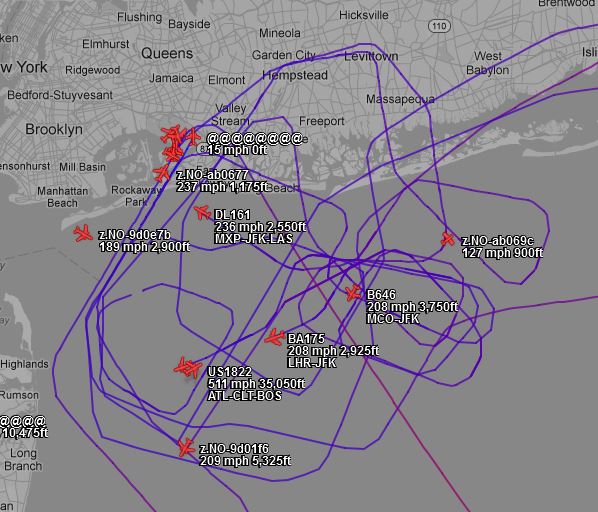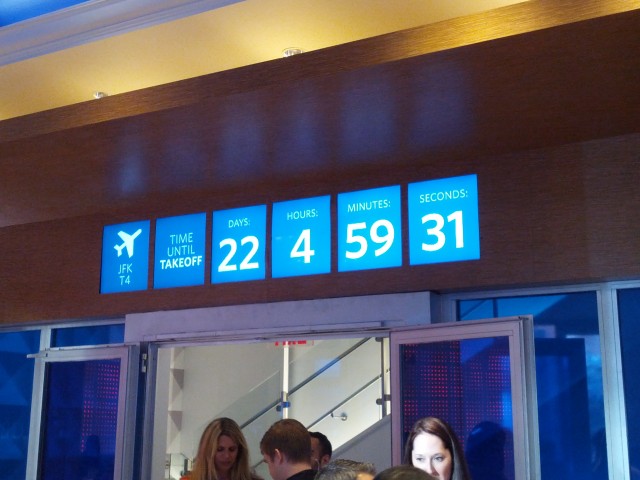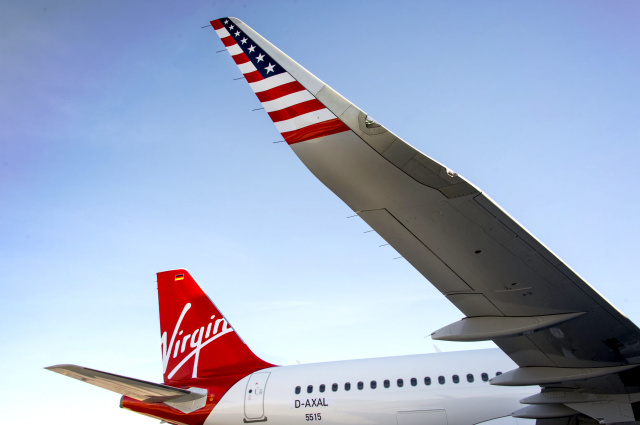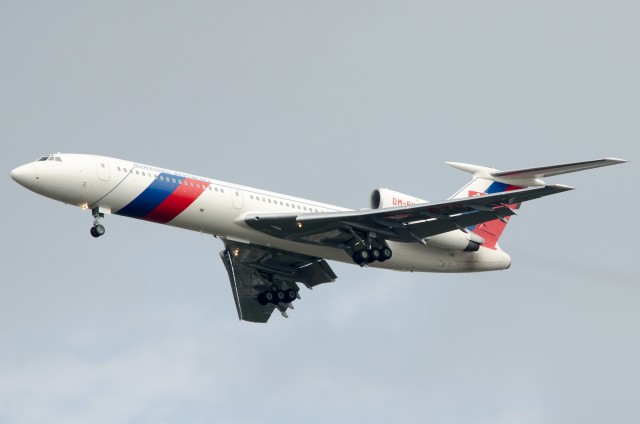
A whole bunch of go-arounds turned the JFK airspace into a tangled web of flight paths
Shortly after noon today at New York’s JFK airport, a powerful thunderstorm cell with cloud tops of 40,000 feet passed over the field and subsequently turned the NY airspace into a tangled mess.
Lightning struck the field a first time, taking down the airport’s runway visual range (RVR) equipment, which is used to measure exactly how far a pilot in the center of the runway is able to see the center line markings. Lightning strikes happen and equipment failures occur all the time, butmoments later, lightning struck yet again, this time taking out the ILS glide slope for runway 4R, the active runway. At that moment, several international heavies were on final approach, forcing missed approaches and go-arounds.

Stop on the ramp while to take a panoramic photo of your aircraft? Sure! Photo by Jason Rabinowitz.
When you think of airports that appeal to AvGeek, a certain few will always come to mind: St. Maarten, Los Angeles, or maybe Paine Field. Some airports that probably don’t come to mind might be West Palm Beach, Burbank, and Ft. Lauderdale, but maybe they should.
In most major American airports, passengers flow directly from the terminal to the aircraft by the use of a jet bridge, never truly getting a good view of the aircraft they are about to board. At some airports, however, if you play your cards right, you are able to board the plane from the ramp, getting an epic view of your soon to be aircraft as you enter through the door. At some locations there passengers can both board from a jetway in the front and via the ramp in the back.

Only 22 days, 4 hours, 59 minutes, 31 seconds until JFK T4 opens…. but who’s counting.
How does an airline spread the word about their new terminal opening soon? If you guessed “rent space in lower Manhattan, recreate the best features of the new terminal, and sell cheap lunches,” you are correct! If that isn’t what you guessed, let me tell you a little bit about how Delta is preparing New York for the new JFK Terminal 4.
On May 24th, Delta opens an expansion to terminal 4 at JFK, moving their operations out of terminal 3. For those of you who many not have flown Delta through JFK recently, terminal 3 has fallen on hard times, and is slated for total demolition in the near future. The experience there is anything but world class, and passengers actively avoid it. Terminal 4, on the other hand, is a 1.4 billion dollar investment at JFK, bringing high tech features, new dining and shopping options, and an overall better experience to New York.

The First Virgin America A320 With Sharklets
At Virgin America’s Newark Airport inaugural celebration this week, I had the opportunity to sit down with CEO David Cush for AirlineReporter.com. While talking about their new Airbus A320 with Sharklets, Cush detailed his airlines future plans for flights to Hawaii.
Jason: ’œYou just took delivery of your first A320 with Sharklets, when do you expect that to enter into service?
Cush: ’œIt should be in about two weeks, let’s call it around April 25th or so.’
Jason: ’œDo you have any idea which route it will be flying initially?’
Cush: ’œIt’ll be flying some of the longer routes, because of the efficiency, so probably San Francisco-Boston, San Francisco-JFK. We took delivery of that one in Hamburg, and it was a beautiful airplane on the way over. Our chief pilot flew it over, and we actually saw greater than 4 per cent efficiency from Sharklets. So they estimated 3.5, we saw a little bit over 4.
Jason: ’œHow do you estimate that will impact your operations?’
Cush: ’œWe fly these aircraft kind of at the edge of their performance. When we’re flying Boston to San Francisco, in the winter and into headwinds, that’s about all that aircraft can do. Now what we got is an airplane that can do that easily without weight restrictions. So it’s not only a fuel efficiency thing, it’s a performance thing.
Jason: ’œI know that JetBlue had taken delivery of the first production retrofit a couple of months ago, and they have been doing that exact route, and they report that they have to make fewer tech stops to refuel. Do you anticipate less stops or was that a problem initially without Sharklets?>
Cush: ’œWe don’t take tech stops. If we’ve got a long flight plan or strong winds, what we do is we basically buy passengers off the airplane. So, rather than inconveniencing everyone, what we’ll do is will find people to buy off, and they’ll wait for the next one. We take very few tech stops, usually when it’s an unplanned change. But what this will mean is that we will never have to take passengers out of the aircraft again.
Jason: ’œHow often do that [buying passengers off the flight] happen right now?’
Cush: ’œI would say during the dead of winter, with a bad jet stream, I would say maybe as much of 10 per cent of the flights out of Boston.
Jason: ’œDo you anticipate the impact of Sharklets being able to open any new routes in the future?
Cush: ’œThe main thing is that it lets you do West Coast to Hawaii, and that’s something you can’t do with the current aircraft. And so we’ll be using Sharklet equipped airplanes in 2015 when we start flying to Hawaii, and we can’t do that without the Sharklets.
Jason: ’œAre there any plans to retrofit current aircraft with Sharklets?’
Cush: ’œWe’re going to wait and see. You know, there’s a lot of work you have to do on the wing, a lot of weight you add to the aircraft, which is a little bit of a challenge for us. We like the fuel efficiency, we don’t like the additional weight, so we’re not in a big hurry to do it. I know JetBlue is really blazing that trail, we’ll probably just sit back and see what their experience is, and if it’s good, we’ll probably go ahead and do the same thing.
Jason: ’œAll future deliveries of Airbus aircraft at this point, will they be Sharklet equipped?
Cush: ’œAll of ours will be. We’re not taking any more airplanes until 2015, and then we’ll take 10 from 2015 to 2016.
 |
This story written by… Jason Rabinowitz, Correspondent.
Jason is a New York City native who has grown up in the shadow of JFK International Airport. A true “avgeek”, he enjoys plane spotting and photography, as well taking any opportunity he can get to fly on an aircraft.
@AirlineFyer | FaceBook |Virgin America, Sharklets, Hawaii |

Tupolev TU-154 (OM-BYO) in Slovakian Government livery. Photo by Jason Rabinowitz.
Last week, a chapter of Soviet aviation has been closed forever. Over 40 years after its entry into service, the final Tupolev Tu-154 has been delivered to the Russian Defense Ministry, according to Russian news agency RIA Novosti. Although full production ceased back in 1997, the Tu-154 remained in limited production for quite some time, with a final total of over 1000 airframes produced. The first Tu-154 was delivered to Aeroflot on February 7, 1972.
The Tu-154 was the last of the commercial ’œtri-jets’ in production, outlasting popular aircraft such as Lockheed L-1011 Tristar and Boeing 727 by several decades, both of which saw ther last deliveries in 1984.
Designed to be the workhorse of the Soviet aviation industry, flying into some of the harshest airfields in the world, the Tu-154 went places other jet powered aircraft of its size could not. With its oversized landing gear, the Tu-154 was even able to land on unpaved runways.
Contrary to popular belief, the Tu-154 was not an unsafe aircraft. According to the the Aviation Safety Network, the Soviet built aircraft has been involved in 110 serious incidents, 68 of which resulted in a hull loss, 30 of which saw no deaths. Several incidents were the direct result of terrorism or military action, poor weather and runway conditions, as well as pilot error and poor maintenance. Comparatively, the Boeing 737 has been involved in 159 hull-loss accidents, though over 7,000 737s have been produced.
A string of recent high profile accidents accelerated the withdrawal of the Tu-154 from passenger service. Most notably, on April 10, 2010, a Polish Air Force Tu-154 carrying many high level government officials, including the President of Poland, crashed near the city of Smolensk, Russia, killing all 96 on board. That accident was blamed not on the aircraft, but on pilot error. These accidents prompted the Russian Federal Bureau of Aviation in March 2011 to recommend the withdrawal remaining Tu-154s from passenger service.
As of early 2012, 104 Tu-154s remained in service with various airlines throughout the world, as well as several military operators. The Russian aerospace industry has yet to produce a strong competitor for Boeing and Airbus. The Sukhoi Superjet 100 is Russia’s latest attempt at competing, but only 223 have been ordered thus far, and competition from countries such as China and Japan is heating up.
The Tu-154 will forever has a place in aviation history as a tank of an aircraft, going where other aircraft wouldn’t even dream of. Although it had its fair share of black eyes along the way, this Soviet designed aircraft stood the test of time.
 |
This story written by… Jason Rabinowitz, Correspondent.
Jason is a New York City native who has grown up in the shadow of JFK International Airport. A true “avgeek”, he enjoys plane spotting and photography, as well taking any opportunity he can get to fly on an aircraft.
@AirlineFyer | FaceBook | |





